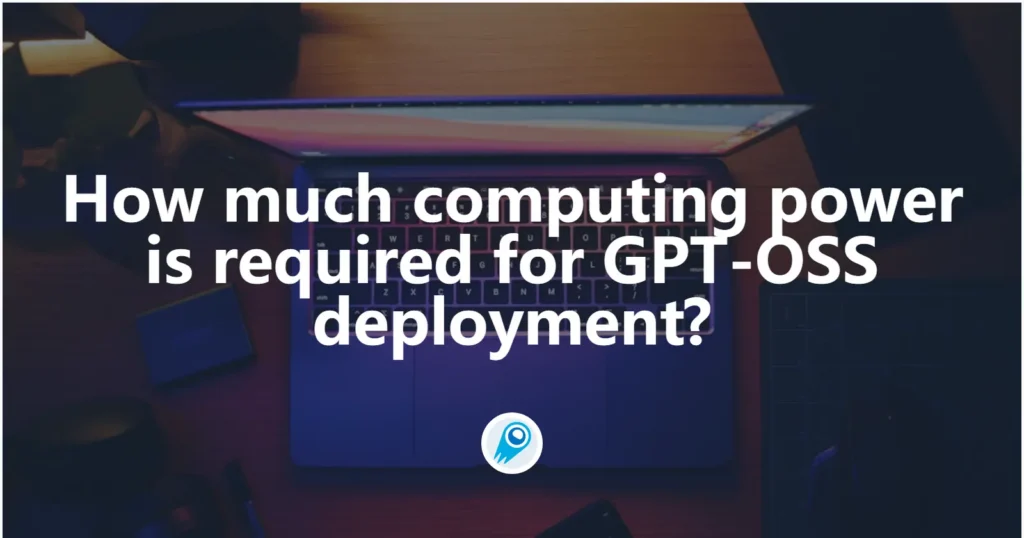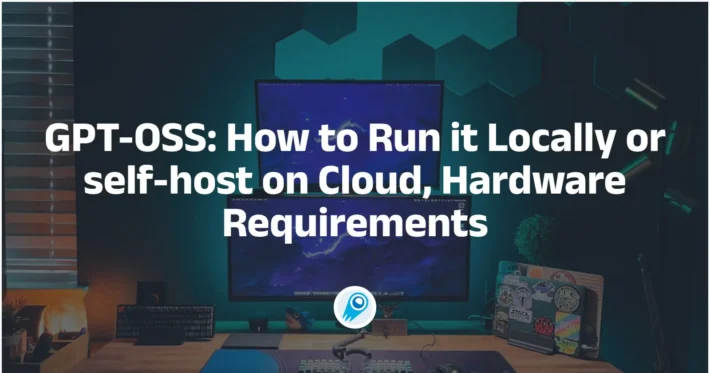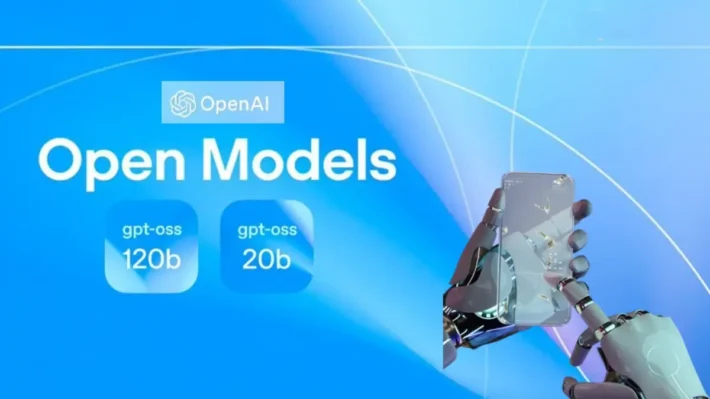How much computing power is required for GPT-OSS deployment?

Open-weight models from major labs have changed the calculus for organizations that want to deploy large language models on-premises or at the edge. OpenAI’s recent gpt-oss family (notably the gpt-oss-20B and gpt-oss-120B releases) explicitly targets two different classes of deployment: lightweight local inference (consumer/edge) and large-scale data-center inference. That release — and the flurry of community tooling around quantization, low-rank adapters, and sparse/Mixture-of-Experts (MoE) design patterns — makes it worth asking: how much compute do you actually need to run, fine-tune, and serve these models in production?
Note: this article refers to inference/deployment compute (what you need to serve the model to users), not the vastly larger compute used to train the models. For context, major vendors train new generations on enormous GPU clusters; that’s a different scale entirely.
What are the baseline compute profiles for gpt-oss models?
What does OpenAI say about the gpt-oss family?
OpenAI’s published specs position gpt-oss-20B as a model that can run on “edge devices with just 16 GB of memory” and gpt-oss-120B as a model that can be used on “a single 80 GB GPU” for many inference uses. The 20B model is targeted at local offline use and rapid iteration; the 120B is designed to give near parity with higher-end “mini” models but with a lower hardware bar than previous 100B+ weights required in full FP16. These are design claims (and will vary by implementation/quantization/precision), but they set a clear intent: one model for consumer/edge, one for data-center single-GPU inference.
How should you interpret those numbers?
Those headline numbers (16 GB, 80 GB) are memory targets, not pure FLOP counts. They reflect a combination of:
- Model weight storage (quantized or full-precision),
- Activation and KV cache memory during inference (which scales with context length and batch size),
- Framework overhead (runtime buffers, CUDA workspace, tokenizer buffers),
- Optional components such as MoE routing overhead or adapter weights.
In practice, model memory + KV cache + working space is the sum that determines whether a model fits into GPU RAM or system RAM. For large context windows (tens of thousands of tokens) the KV cache can itself consume tens of GBs, shifting the effective hardware need upward.
Why model size matters
The dominant factor for deployment compute is model size in parameters because that determines raw weight storage and activation memory. A rough rule-of-thumb used by practitioners: FP16 (half-precision) storage needs ~2 bytes per parameter, so a 70B model in FP16 is ~140 GB of weight memory alone — and additional memory is required for activations, optimizer state (if fine-tuning), and framework overhead. That arithmetic explains why models are often split across GPUs or quantized for single-GPU use.
What determines “how much compute” a GPT-OSS deployment needs?
When people ask “how much compute,” they usually mean one or more of the following measurable resources:
- GPU memory (VRAM): the limiting factor for loading model weights and serving tokens.
- GPU compute (FLOPS / tensor throughput): affects latency and tokens per second.
- Number of GPUs and interconnect (NVLink / PCIe / network): determines ability to split model across devices for large weights.
- CPU, RAM, and storage: supporting components for pre/post-processing, caching, and model weight storage.
- Inference software stack and optimizations: frameworks like Hugging Face Text-Generation-Inference (TGI), vLLM, NVIDIA Triton and techniques like quantization or offloading change effective requirements a lot.
These dimensions interact: a quantized model needs less VRAM but still benefits from a faster GPU for low latency. Conversely, a high-throughput setup with many simultaneous users needs both memory and strong GPU compute or clever batching.
How much memory does inference use for a 20B vs a 120B model?
How much memory do the raw parameters require?
Parameter count alone is an imperfect metric because memory per parameter depends on numeric precision:
- FP32 costs 4 bytes/param; FP16/16-bit float costs 2 bytes/param.
- 8-bit, 4-bit and even 3-bit quantization reduce that dramatically (e.g., 4-bit ≈ 0.5 bytes/param plus small dequantization tables). Techniques like GPTQ, AWQ and ML-specific quantizers bring large reductions in practice.
Using rough math:
- A 20B-parameter model at FP16 ≈ 40 GB raw (20B × 2 bytes). With optimized 4-bit quantization it can fall below ~16 GB (plus small overhead) — which aligns with the gpt-oss-20B target when combined with runtime tricks.
- A 120B-parameter model at FP16 ≈ 240 GB raw. To make that fit into a single 80 GB GPU, the model must use compression/quantization and/or sparse activations (e.g., MoE where only a subset of experts are active for a token), reducing the active memory footprint dramatically. OpenAI’s documentation describes design choices (sparsity, grouped multi-query attention, and new quantization schemes) that allow the 120B weights to be effectively deployed into ~80 GB of device RAM for common inference use cases.
What about KV cache and context length?
Context length is a first-class citizen for memory planning:
- KV cache memory scales roughly as:
(#layers) × (head_dim) × (context_length) × 2(keys + values) × element_size. - For large models with long windows (64K–131K tokens supported by some gpt-oss configs), KV cache can become the dominant memory consumer, often requiring tens to hundreds of GBs for full-length processing. If you need to support very long context windows at high throughput, expect to reserve substantial additional GPU memory or offload the KV cache to CPU/host RAM or specialized sharded KV caches.
Are quantization and sparse architectures the key to lowering compute?
Quantization—reducing numeric precision of weights and activations—drives the single largest reduction in VRAM requirements for inference and for low-cost fine-tuning.
Quantization (post-training or during conversion) is the single most powerful lever for reducing memory and often improves inference throughput because more of the model fits in fast caches. Techniques that are widely used in 2024–2025 include GPTQ, AWQ and custom 3–4-bit quantizers; community benchmarks show that 4-bit quantization frequently causes negligible loss in quality while cutting memory by ~4× versus FP16. These techniques are now mature enough to be part of standard deployment pipelines.
How do sparse / MoE designs
Mixture-of-Experts (MoE) models reduce active parameter counts per token by routing tokens to a small set of experts. That means a 120B parameterized model can activate only a fraction of its weights for any single token, dramatically lowering memory and flop needs for inference. OpenAI’s gpt-oss architecture uses MoE and other sparsity patterns to make the 120B variant practically usable on a single high-memory GPU. However, MoE adds runtime complexity (routing tables, load balancing, potential communication overhead in multi-GPU setups) that you must plan for.
How do inference frameworks and serving architecture change compute needs?
Single-GPU vs multi-GPU vs disaggregated serving
- Single-GPU: simplest deployment; best for small models (≤13B) or large models heavily quantized.
- Multi-GPU sharded serving: splits weights and/or activations across GPUs; required for 70B+ models in FP16 without quantization. NVLink or high-bandwidth interconnects improve latency.
- Disaggregated / model parallel serving: modern solutions push compute into fleets with memory disaggregation (weights stored across machines), with a separate fast cache of hot layers on GPU. NVIDIA’s new Dynamo/Triton platform and other inference orchestration layers explicitly support these patterns to scale LLM inference while optimizing cost and latency.
H3: Frameworks and software that matter
- Hugging Face Text Generation Inference (TGI) — provides optimized serving for many open models and supports batching, token streaming, and model optimizations.
- NVIDIA Triton / Dynamo (Triton → Dynamo Triton) — enterprise inference server with LLM-specific optimizations and support for Blackwell/H100 architectures, used for high-throughput, low-latency fleets.
- vLLM / ExLlama / llama.cpp / GGUF pipelines — community and academic projects that optimize memory and CPU/GPU kernels to squeeze larger models into smaller hardware footprints.
Selecting the right framework affects whether you need dozens of GPUs (naive sharding) or can achieve the same latency with fewer devices thanks to better memory management, kernel fusion, and quantized kernels.
What are representative deployment examples and hardware recommendations?
Example 1 — Local developer / on-premise laptop (gpt-oss-20B)
- Target: Interactive development, private local inference, small-scale testing.
- Minimum practical spec: A consumer or workstation GPU with 16–32 GB RAM (M1/M2/M3 Macs with 32+ GB or a PC with an RTX 4090/4080 / RTX 6000 with 24–48 GB) plus SSD storage for model files. Use 4-bit quantization and optimized runtimes (llama.cpp/ggml, ONNX Runtime or Ollama). This setup handles moderate context lengths with reasonable latency.
Example 2 — Single-GPU data-center inference (gpt-oss-120B)
- Target: Production inference at moderate throughput.
- Recommended spec: Single 80 GB GPU (A100 80GB, H100-80GB or similar), server CPU and 512 GB+ system RAM for offload and buffering, NVMe storage for fast model load. Use the gpt-oss official builds / optimized kernels and heavy quantization + MoE activation sparsity. This provides good balance between cost and capability for many commercial workloads.
Example 3 — High-throughput, low-latency at scale
- Target: Thousands of qps, stringent latency targets, long context windows.
- Recommended spec: GPU clusters with model sharding (tensor parallelism + pipeline parallelism) across multiple A100/H100 cards or newer inference accelerators; KV cache sharding or CPU offload; and autoscaling on cloud GPU-pools. You will need to account for networking (NVLink / PCIe / RDMA), distributed runtime overhead, and careful batching strategies. MLPerf and independent benchmarking work provide reference points for multi-GPU setups.
How does throughput vs latency affect the compute you need?
What’s the trade-off between latency and batching?
- Batching increases throughput (requests per second) but also increases latency for any single request. CPU/GPU occupancy can be maximized with larger batches, but user-facing applications often prefer low per-request latency.
- Model size intensifies this trade-off: bigger models yield higher per-token cost, so they either need larger batches to reach cost-effective throughput or more GPUs to spread load without hurting latency.
Workload profiling is indispensable: measure tokens/sec per GPU at your target batch sizes and latency budget, then provision accordingly. Use autoscaling and request-level batching logic (micro-batching, growth windows) to maintain SLAs.
How much will it cost to run gpt-oss in production?
What are the operational cost drivers?
Three factors dominate cost:
- GPU hours (type and count) — biggest line item for heavy models.
- Memory and storage — NVMe for model shards and caching; RAM for KV offload.
- Engineering time — ops to manage sharding, quantization pipelines, monitoring, and safety filtering.
To make a rough estimate:
For a single A100 80GB instance used for steady inference, cloud hourly costs (depending on region and commitment) plus amortized engineering and networking often result in hundreds to low-thousands of dollars per day for medium workloads. Pushing to multi-GPU clusters multiplies that cost. Exact numbers depend on provider discounts, reserved instances, and your throughput/latency profile. Recent hardware guides and benchmarks provide sensible cost per qps baselines you can adapt for your forecast.
What operational techniques reduce compute and cost?
Which software and model tricks matter most?
- Quantization (GPTQ/AWQ) to 4-bit/3-bit reduces weight storage and often speeds inference.
- LoRA / QLoRA for fine-tuning lets you adapt large models with far less GPU memory and compute.
- MoE / sparse activations reduce active parameter usage at inference time, at the cost of routing complexity.
- KV cache offload (move to host RAM or disk with smart async IO) for very long contexts.
- Model distillation or composition: distill gateway models or use retrieval to reduce calls to the big model for straightforward tasks.
What runtime choices matter?
Choose highly optimized runtimes (ONNX Runtime, Triton, custom CUDA kernels, or community runtimes like llama.cpp for CPU inference) and leverage tensor cores, batching, fused kernels, and memory-mapped model loading to maximize utilization. These choices often change the effective hardware requirement more than small improvements in model size.
What are the practical pitfalls and gotchas?
What could make your compute needs explode unexpectedly?
- Long context windows: KV cache growth can blow your memory budget. Plan for offload.
- High concurrency: Many simultaneous users will require horizontal scaling, not just a single beefy GPU.
- Safety filters and pipelines: Moderation models, embedding stores, and retrieval can add CPU/GPU overhead to each request.
- Framework mismatches: Using unoptimized operators or failing to use quantized kernels can make claimed memory/latency numbers unrealizable.
Conclusion — how much compute do you actually need?
There’s no single answer, but modern open-weight releases like gpt-oss have materially lowered the bar:
- For many use cases, consumer/workstation class hardware (≈16–32 GB RAM with 4-bit quantization) can run a 20B-class model well for local/edge use.
- For high-capability single-GPU inference, an 80 GB GPU is a sensible baseline for 100–200B-parameter families when combined with quantization and sparsity.
- Fine-tuning is practical at scale using LoRA/QLoRA on single machines for many tasks; full training of 100B+ models remains a multi-GPU datacenter activity.
Finally, remember that software choices (quantizers, runtimes, batching strategy) often change the hardware calculus more than small differences in parameter counts. Start from your SLA, profile early, and adopt quantization and parameter-efficient adaptation strategies to minimize cost without sacrificing quality.
How to Access GPT-OSS API
CometAPI is a unified API platform that aggregates over 500 AI models from leading providers—such as OpenAI’s GPT series, Google’s Gemini, Anthropic’s Claude, Midjourney, Suno, and more—into a single, developer-friendly interface. By offering consistent authentication, request formatting, and response handling, CometAPI dramatically simplifies the integration of AI capabilities into your applications. Whether you’re building chatbots, image generators, music composers, or data‐driven analytics pipelines, CometAPI lets you iterate faster, control costs, and remain vendor-agnostic—all while tapping into the latest breakthroughs across the AI ecosystem.
Developers can access GPT-OSS-20B and GPT-OSS-120B through CometAPI, the latest models version listed are as of the article’s publication date. To begin, explore the model’s capabilities in the Playground and consult the API guide for detailed instructions. Before accessing, please make sure you have logged in to CometAPI and obtained the API key. CometAPI offer a price far lower than the official price to help you integrate.


